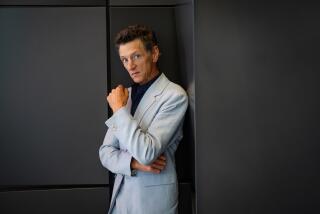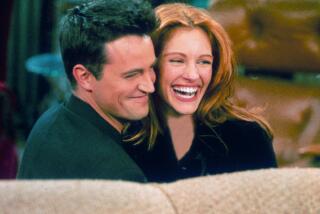John Hawkes enters virgin territory in ‘The Sessions’
NEW YORK — In “The Sessions,” John Hawkes plays a journalist who writes romantic poetry, tells dry, self-deprecating jokes and wiles away his afternoons in bed with a beautiful woman. He’s just another sigh-inducing, big screen heartthrob, in other words — except for the iron lung.
“The Sessions,” which opens Friday, is the mostly true and surprisingly upbeat story of Mark O’Brien, a polio victim who decided to lose his virginity at the age 38 with the help of a sex surrogate. Written and directed by Ben Lewin, himself a polio survivor, and costarring Helen Hunt as the surrogate, the movie presented Hawkes with a host of physical challenges, from contorting his body painfully to duplicate O’Brien’s twisted spine to mastering the disabled man’s halting breathing style.
But it was O’Brien’s dogged approach to a more conventional dilemma — a quest for a sexual touch — that drew Hawkes to the role.
PHOTOS: Celebrities by The Times
“A character like that had every reason to wallow, but that’s just not interesting to watch on screen,” Hawkes said during an interview at a SoHo hotel. “I’ve played a lot of underdogs and I like people who aren’t equipped to solve their problems but just keep trying anyway. There’s something really noble and interesting about watching someone keep banging their head against the wall.”
Hawkes, 53, first learned about the project after playing a backwoods meth addict in the 2010 drama “Winter’s Bone.” After years of toiling in relative obscurity as a character actor — his most notable role was an upright businessman in the lawless West on HBO’s “Deadwood” — he was nominated for a supporting actor Academy Award for “Winter’s Bone,” and suddenly began receiving plum scripts. The one on the stack with the most intriguing role, and, at roughly $1 million, the lowest budget, was “The Sessions.”
When he first met Lewin about the part, however, Hawkes expressed a concern — whether Mark O’Brien should be played by a disabled actor. It was a path Lewin had already been pursuing, with no success.
“For me to go and find a slightly disabled actor and pretend that they were severely disabled might amount to tokenism if the performance wasn’t right,” said the Polish-born Lewin, who has worked mostly in TV and on documentaries. “I thought I had a responsibility to the movie as a whole not to make a political gesture. But it impressed me that this was legitimately one of John’s concerns. It was the first question he asked me.”
They also discussed — and dismissed — the idea of using a body double for the scenes that showed O’Brien’s curved spine. Instead Hawkes, who naturally has a slight build, found other ways to approximate O’Brien’s physicality.
PHOTOS: Hollywood backlot moments
Hawkes and the props department created what became known on set as his “torture ball,” a soccer ball-sized foam pad he tucked under the left side of his back to force his body to curve dramatically. He also fashioned a mouth stick like the kind O’Brien used to turn the pages of a book and dial a telephone, and learned to manipulate it.
Among the hardest tasks was holding the awkward poses completely still for long stretches — something Hawkes’ chiropractor warned him against. (He did yoga to help undo the damage).
Hawkes also immersed himself in O’Brien’s inner life, reading his writing, including the article “On Seeing a Sex Surrogate,” that had inspired the film, and watching Jessica Yu’s short documentary about O’Brien, “Breathing Lessons.” O’Brien, who lived in Berkeley, was a journalist and poet who died in 1999.
As he drove to and from his Hollywood Hills home to the set during the 22-day, Los Angeles-based film shoot, Hawkes listened to audio from Yu’s short to better internalize O’Brien’s peculiar cadence of talking and breathing.
“The first time I heard John I got chills,” said Cheryl Cohen Greene, the real-life surrogate upon whom Hunt’s character is based. “I’m sitting there on the set with headphones thinking, that’s Mark. It’s scaring me. John got him completely.”
When it came time to shoot the sex scenes, Hawkes and Hunt had another unusual task. Typically actors are supposed to transform the decidedly unsexy environment of a film set into a romantic and chemistry-charged scene — in “The Sessions,” they were supposed to be uncomfortable and wary.
“I can’t stand watching sex scenes in movies,” said Lewin. “Particularly I can’t stand the rolling. In this case, the difficulty and awkwardness of it was palpable. We all just silently agreed that that was the way we were going to do it, to use the real unfamiliarity. It’s a gamble but I’m very glad they took it.”
As the scenes unfold, Hawkes and Hunt’s characters develop a deeper attachment — and a key part of Hawkes’ work was making a man confined to a gurney seem not like a victim but like a leading man.
“Mark had great charm, an enormous facility with words, and maybe an ability to tell a woman what she wanted to hear,” said Lewin. “He was a real and accomplished romantic. John also has some of those qualities. That allowed me to play this as a relationship movie.”
Hawkes’ unusually angled face looks more like it belongs on a daguerreotype than in a 2012 romantic comedy, which helps explain his other big role this fall — as a lobbyist helping get the 13th Amendment passed in Steven Spielberg’s “Lincoln.”
“I don’t think I have any danger of becoming a mega superstar movie star any time soon,” he said. “There’s no brass ring or top of the ladder I’m trying to get to. I’d be happy to ride it out from here.”
PHOTOS AND MORE:
PHOTOS: Hollywood back lot moments
Latest movie reviews
PHOTOS: NC-17 movies: Why they got the rating
More to Read
Only good movies
Get the Indie Focus newsletter, Mark Olsen's weekly guide to the world of cinema.
You may occasionally receive promotional content from the Los Angeles Times.











